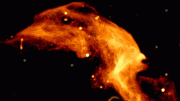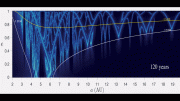
Researchers were able to control the behavior of various light frequencies that passed through a specially designed cavity. The successful experiment can pave the way fiber optic advances that offer greater facility in energy storage, computing and signal processing. Credit: Xuefeng Jiang
Exploring the interaction of light beams in a stadium-shaped arena provides scientists with a deeper understanding of its complex behavior.
Harnessing and controlling light plays a pivotal role in technological advancement, impacting energy harvesting, computation, communications, and biomedical sensing. Nevertheless, in real-world scenarios, the intricate behavior of light presents challenges for efficient control.
Physicist Andrea Alù draws a parallel between the behavior of light in chaotic systems and a game of billiards, where slight variations in the cue ball’s launch result in different ball trajectories on the table.
“In billiards, tiny variations in the way you launch the cue ball will lead to different patterns of the balls bouncing around the table,” said Alù, Einstein Professor of Physics at the CUNY Graduate Center, founding director of the Photonics Initiative at the CUNY Advanced Science Research Center and distinguished professor at CUNY. “Light rays operate in a similar way in a chaotic cavity. It becomes difficult to model to predict what will happen because you could run an experiment many times with similar settings, and you’ll get a different response every time.”
In a new study published in Nature Physics, a team led by researchers at the CUNY Graduate Center describes a new platform for controlling the chaotic behavior of light by tailoring its scattering patterns using light itself. The project was led by co-first authors Xuefeng Jiang, a former postdoctoral researcher in Alù’s lab who is now an assistant professor of Physics with Seton Hall University, and Shixiong Yin, a graduate student in Alù’s lab.
Traditional Platforms vs. Chaotic Cavities
Conventional platforms for studying light’s behaviors typically use circular or regularly shaped resonant cavities in which light bounces and scatters in more predictable patterns. In a circular cavity, for example, only predictable and distinct frequencies (colors of light) survive, and each supported frequency is associated with a specific spatial pattern or mode. One mode at a single frequency is sufficient to understand the physics at play in a circular cavity, but this approach does not unleash the full complexity of light behaviors seen in complex platforms, Jaing said.
“In a cavity that supports chaotic patterns of light, any single frequency injected into the cavity can excite thousands of light patterns, which is conventionally thought to doom the chances of controlling the optical response,” Jaing said. “We have demonstrated that it is possible to control this chaotic behavior.”
The Innovative Stadium-Shaped Cavity
To address the challenge, the team designed a large stadium-shaped cavity with an open top and two channels on opposing sides that direct light into the cavity. As incoming light scatters off the walls and bounces around, a camera above records the amount of light escaping the stadium and its spatial patterns.
The device features knobs on its sides to manage the light intensity at the two inputs, and the delay between them. Opposing channels cause the light beams to interfere with each other in the stadium cavity, enabling the control of one beam’s scattering by the other through a process known as coherent control—essentially, using light to control light, according to Alù. By adjusting the relative intensity and delay of the light beams entering the two channels, remarkably, researchers consistently altered the light’s radiation pattern outside the cavity.
Unlocking Control with Reflectionless Scattering Modes (RSMs)
This control was enabled through a rare behavior of light in resonant cavities, called “reflectionless scattering modes” (RSMs), which had been theoretically predicted before but not observed in optical cavity systems. According to Yin, the ability to manipulate RSMs demonstrated in this work allows for the efficient excitation and control of complex optical systems, which has implications for energy storage, computing, and signal processing.
“We found at certain frequencies our system can support two independent, overlapping RSMs, which cause all of the light to enter the stadium cavity without reflections back to our channel ports, thus enabling its control,” said Yin. “Our demonstration deals with optical signals within the bandwidth of optical fibers that we use in our daily life, so this finding paves a new way for better storage, routing, and control of light signals in complex optical platforms.”
The researchers aim to incorporate additional knobs in future studies, offering more degrees of freedom to unravel further complexities in the behavior of light.
Reference: “Coherent control of chaotic optical microcavity with reflectionless scattering modes” by Xuefeng Jiang, Shixiong Yin, Huanan Li, Jiamin Quan, Heedong Goh, Michele Cotrufo, Julius Kullig, Jan Wiersig and Andrea Alù, 2 November 2023, Nature Physics.
DOI: 10.1038/s41567-023-02242-w









Be the first to comment on "Unlocking Light’s Mysteries – Scientists Discover New System To Control the Chaotic Behavior of Light"